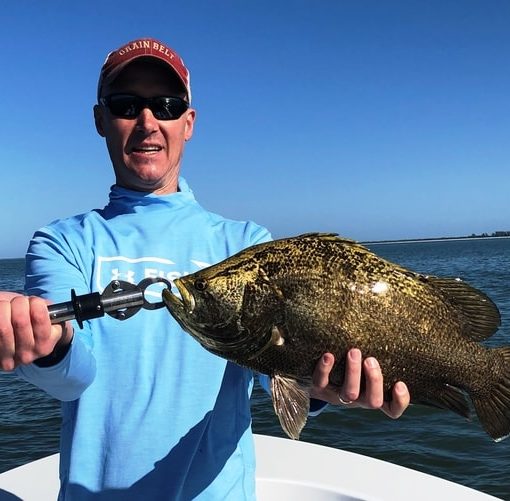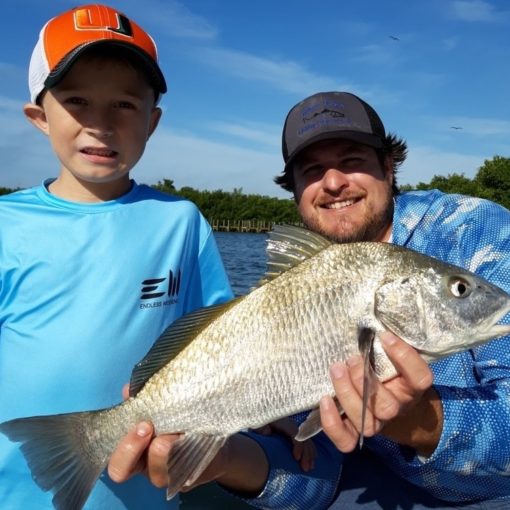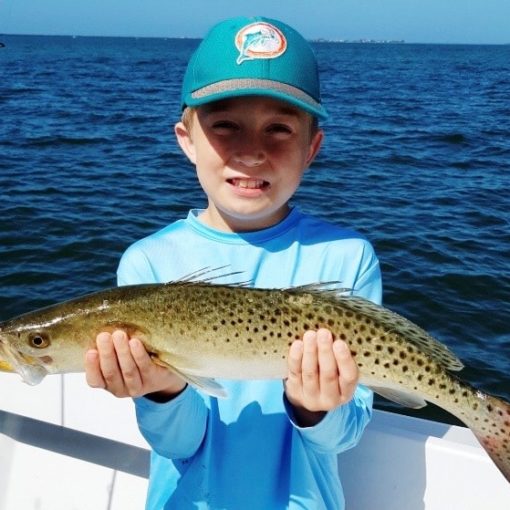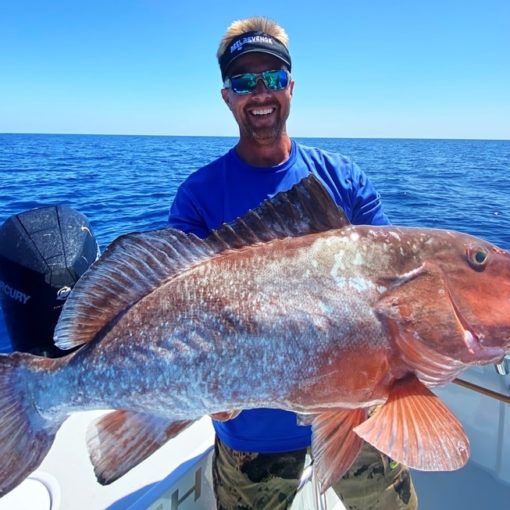Been out on the water around Florida recently and seen what looks like a shark fin gliding towards you? Whilst sharks do abound in our waters, it’s also highly possible you’ve spotted a cobia instead. You may know this prolific game fish by one of its various other names including black kingfish, lemonfish, ling and black bonito.
Cobia is the sole member of the Rachycentridae family. It gets its scientific name Rachycentron canadum courtesy of the 6-9 short sharp spines on its large pectoral fin. ‘Rachis’ and ‘kentron’ are Greek for ‘spine’ and ‘sting’ respectively. When this fin is upright, which is most of the time, it gives the cobia its ‘sharklike’ appearance in the water! Blue Line Charters offer custom cobia fishing charters off Florida and Cape Coral.
Shark Or ‘Just’ Cobia?
The fact that cobia can be mistaken for sharks gives us a few pointers about them. Like sharks, they’re a large and elegantly streamlined fish with a broad flat head. Mature adults can reach 6 feet and weigh up to 150 pounds. The largest specimen caught with a rod and reel weighed 135 pounds and was caught at Shark Bay in Western Australia. The state record here in Florida is 130 pounds for one caught in Destin. However, most of the ones you’ll catch around here are between 10 and 50 pounds. That’s still a good size for most anglers.
Here in southeast US, cobia spend the winter months in the Gulf of Mexico. They then head north up the Atlantic coast for summer, often going as far up as Massachusetts. We typically see them passing our Florida coastline during March.
Finding Cobia
The Shark Bay catch on the other side of the world is a clue to cobia’s widely dispersed global habitat. You’ll find them in the Caribbean, along the eastern and western Atlantic and Indian Ocean coastlines, and off Japan’s Pacific coast. They are an inshore and nearshore species with a preference for coastlines that have plenty of bays and inlets. Adult cobia typically live in and around structures like docks, reefs, and wrecks along these coastlines but will venture inland in search of prey.
Cobia naturally favor warm tropical and temperate marine waters. However, as a euryhaline and eurythermal species they can tolerate a wide range of salinities (euryhaline) and water temperatures (eurythermal). Their salinity tolerance range is 5.0 to 44.5 ppt so they can venture into near fresh water systems in search of prey. Likewise, they can survive in water temperatures ranging from near freezing through to a balmy 90°F. Such highly adaptive features are a large part of the reason they’re found in so many places around the world.
Other Interesting Information And Feeding Habits
Cobia also lack a swim bladder, the organ that allows most other fish species to control their buoyancy in water. To stay ‘afloat’ they must keep moving, which makes them a very active and agile fish.
When it comes to food, cobia eat crabs, smaller fish including small cobia, and squid. They will also follow other marine animals around to scavenge on their leftovers.
Identifying Cobia
Cobia are distinctively colored with a dark back and broad horizontal dark brown and light lateral stripes. The stripes are very predominant on juveniles but tend to become less striking as the fish matures. However, the brown stripe will darken again during spawning whilst the cream areas lighten.
Spawning Habits
As adults, cobia spend most of their time living in solitary splendor. They are aggregate broadcast spawners though so must come together in large groups at spawning time. Spawning season for cobia in this part of the world is from April to September. Females release between 375,000 and 2,000,000 eggs per spawn, and can spawn up to 30 times a season! Yet another reason why this is such a prolific species around the world!
Newly fertilized cobia eggs are pelagic, meaning they float in the water column as part of the plankton. At this point they’re vulnerable to any species that feeds on plankton. The eggs hatch around 24 hours after release and the larvae grow rapidly. During the first week they remain in the plankton before moving into more protected environments for safety.
Aquaculture Vs Wild Cobia Fishing Trips
Cobia are an excellent and hugely popular meat fish. For this reason they are now extensively farmed in hatcheries, notably in China and Japan. Most of the cobia you buy in shops and restaurants is now farmed. However, that doesn’t detract from the thrill of catching one in the wild. If you’d like to experience this thrill for yourself, contact us at Blue Line to arrange your exciting Cape Coral fishing charter.





